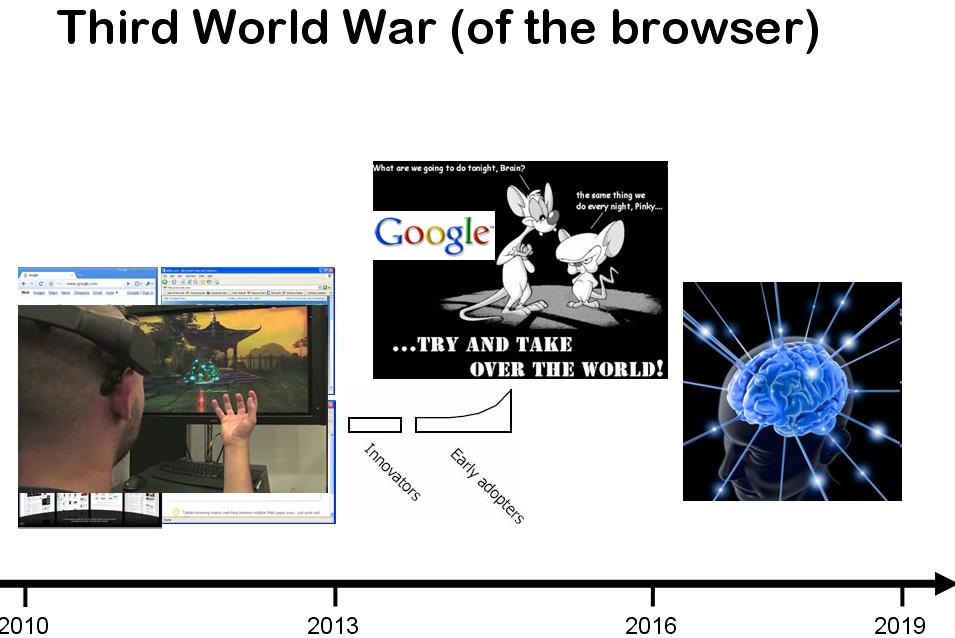Scenario 4, SandBoxMania:
SandBox Mania, a visualized secure Internet experience
The internet as we know it today, and especially the internet experience is in fact a very immature way of retrieving and sending information. Corporate and social environment tend encourage people to do more and more of their work using this 'new' medium. It seems however, that everybody agrees in abandoning the 'Internet-way' of communicating sometimes. Then it is time for a real Face2Fae meeting. Visual expressions and body language, in short terms: Visual Data are still so important for us!
That immediately shows one of the major problems of the Internet today. Using the Internet, personal communication is very well possible. The problem however is that most of the data as it is represented to he user, is based on text. Images and videos are used separately in order to provide us with a picture of what is meant in the text. The future Internet use will be like walking trough an airport. Searching for the proper hall by using Icons that are backed-up by one or two words.
Another big change will come from the developers' corner. Currently development focus is shifting to open source software. Software of which the quality cannot always be guaranteed. Commercial software developers, during the past ten years have tried to live up to the demand for the use of open source software by creating 'Virtual Machines'. These are virtual environments on top of the computers' operating system in which applications can run. The Virtual Machine limits the type of operations an application can carry out on the operating system, e.g. the use of the filesystem, accessing the internet or using a webcam.
This upcoming trend for Virtual Machine 'sandboxes' is creating a completely new business model for the manufacturers of the operating systems. Because they do no longer have to worry about the security of 'home grown' applications, they shift their emphasis to enabling more and more people to develop for their 'sandboxed' platforms. Money is now made by selling the development tools to the open source community and by providing support about the technical possibilities of their samdbox.
Timeline
2010-2013
Time for a change?
The current economic crisis will just be on the level of entering a stage where world economies are once again able to invest in new research & development. Companies will have to take some risk to attract more and more customers. With this stage setting we look at the browser market in 2010.
The most browsers will work the same way as they do now. Only some evolutionary changes will be added by different developers to keep one step ahead from the competition. While the big players in the browser market stick to the original design of the browser (one window to access the Internet) a small new entrant will appear into the market. This new player will introduce a new concept in which ways a browser can be interacted with using a new input device for the personal computer. This small company will pair its new browser with the new input device (a headwear that can be placed over the head); with this their new browser can be controlled with only thoughts. Also the browser itself will have much more advanced functionalities then conventional browsers. This can be enabled because the input device is not as limited as a keyboard and mouse.
This new concept will only appeal to the early adopters at first, but will gradually manifest itself on a bigger community.
2013-2016
New dominant design
The big browser developers (Microsoft, Apple, Firefox etc.) will take notice of this small entrant. Eventually after being persuaded by what the users want, Google will buy this new company and their concept because they want to increase there market share. Google will enhance the technology by investing much money into the project. This will lead toward a new dominant design for browsing and input devices for the personal computer altogether. By 2016 the W3C will approve this as a standard for the World Wide Web. The bigger developers have to be on the lookout for the emerging economies in these times. The emerging economies will have developed substantially and will have their own vision and strategy to capture the world browser market by their concepts.
2016-2019
Its wartime again
Other developers cannot stay behind with their conventional browsers and will try to imitate the new concept obtained by Google. This will lead into the third browser war. During this period, the conventional input devices will disappear. The new headwear will have become the standard in every home and office environment. In this browser war, the developers will only focus on developing browsers with more affluent user experience and will try to push the new input device to its limits by adding newer functionalities. The constant push to innovate this product by the developers will slowly lead to the point that one browser will eventually have all the thinkable functionalities in this technological cycle. Eventually one developer will come out as the winner.
Conclusion
The Internet will be a place where interaction can be really felt instead of being imitated. Conventional input methods will be replaced by newer ones that enhance our overall experience of the World Wide Web. The focus on interaction with the browser will be central. The individual will interact with a browser and the Internet; because of the uniqueness of a user only one single identity will be needed. This could be acquired through the biometrics input device that is being used.
The strategy regarding Mozilla should be to prepare for this scenario by looking at ways to enrich the browser experience not by the conventional standards at hand, but by newer and innovative technologies.
